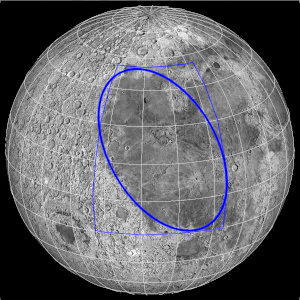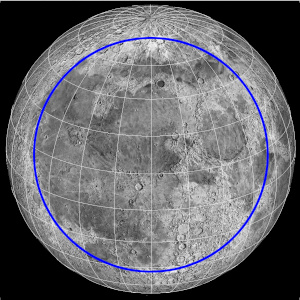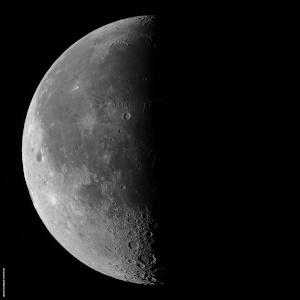
{
Practical astronomy
|
Astronomy
|
The Moon
|
The physical Moon
|
The Lunar 100
}
Lunar #95: Oceanus Procellarum
This is a strange entry in Wood's list. Oceanus Procellarum is the largest of the maria. Everyone has seen it or read about it. And yet, it is near the bottom of the Lunar 100 list and the data in the list are suspicious. The Atlas virtuel de la Lune gives a credible position but a woeful underestimate of its size.
One problem is that the Oceanus is not circular. Its boundaries may be more to do with where neighbour maria and highlands are than with the impact basin itself. As such the shape could be quite irregular. Perhaps most accurate is to say that its longitude extent is from −80° to −25° and its latitude extent is from −15° to +55°, resulting in a central position of −55°,+20°. I rounded these figures to the nearest 5° from those adopted by the IAU in 1935 (IAU, USGS, NASA 2010a).
Images:
- Screenshot from Atlas virtuel de la Lune using its texture of drawn relief with albedo. The thin blue lines indicate the longitude-latitude box given by the IAU. I added the blue ellipse as a more likely, if very simplified outline of the Oceanus. Clearly there remains an unwanted overlap with Mare Imbrium and an unwanted inclusion of the highland area between Mare Imbrium, Mare Frigoris and Oceanus Procellarum.
- An equivalent screenshot to illustrate the giant impact hypothesis that results in the size and position given by Wood in his Lunar 100 list.
- The western half of the Moon on 2021-12-27, stacked from 5 raw frames taken with a Telementor II refractor of f = 840 mm and f/D = 13.3 and Canon EOS 600Dα camera. Unsharp mask. Libration was −6.7° in longitude and −4.6° in latitude; the phase was −48% (Last Quarter).
Wood seems to follow a different definition of the Oceanus Procellarum than the IAU did in 1935. In this, the Oceanus is circular and of 3200 km diameter; it encompasses most maria of the Earth-facing side: Frigoris, Humorum, Nectaris, Imbrium, Serenitatis, Tranquillitatis, and Procellarum proper. However, in this definition Lunar 95 is almost the same as Lunar 1 (the Moon) and Lunar 3 (mare/highland dichotomy). The definition may make physical sense, though: The Oceanus might then be the result of a giant impact of an asteroid or similar. All the "lesser" maria and intervening highland regions would have come about later and now obscure the large, presumed basin.
Refer to Wood's list (2004a and 2012a) and to his notes (cf. Hardwick 2013a). Compare your observation with the Atlas virtuel de la Lune (Chevalley and Legrand 2012a). In this atlas, at high resolution, in general, consider a photographic texture like the LRO WAC mosaic as well as the synthesised topography of the LOLA Kaguya Shade texture. For regions near the lunar limb, changing from the foreshortened Earthlings' perspective to the vertical view down on the Moon can be instructive.



